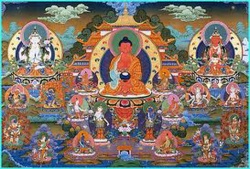Difference between revisions of "Buddha land"
| Line 4: | Line 4: | ||
[仏国土] (Skt [[Buddha]]-kshetra; Jpn bukkoku-do ) | [仏国土] (Skt [[Buddha]]-kshetra; Jpn bukkoku-do ) | ||
| − | Also, [[Pure land]], Land of Tranquil [[Light]], or Land of Eternally Tranquil [[Light]]. In [[Buddhism]], a land where a [[Buddha]] dwells after having vowed to save living beings, completed his own practice, and attained [[Enlightenment]]. The [[Sanskrit]] word kshetra means land. According to the [[Sarvastivada]] school, a major Hinayana school, the saha [[World]], or the [[World]] in which [[Shakyamuni Buddha]] appeared, is the only [[Buddha]] land. In contrast, [[Mahayana Buddhism]] makes reference to numerous [[Buddhas]] and their lands; it describes, for instance, [[Akshobhya]] [[Buddha]]'s Land of [[Joy]] located in the east, [[Amida Buddha]]'s Land of Perfect Bliss in the west, and [[Medicine Master Buddha]]'s Pure Emerald [[World]] in the east.[[Mahayana Buddhism]] developed the concept of the three bodies of a [[Buddha]]: [[ | + | Also, [[Pure land]], Land of Tranquil [[Light]], or Land of Eternally Tranquil [[Light]]. In [[Buddhism]], a land where a [[Buddha]] dwells after having vowed to save living beings, completed his own practice, and attained [[Enlightenment]]. The [[Sanskrit]] word kshetra means land. According to the [[Sarvastivada]] school, a major Hinayana school, the saha [[World]], or the [[World]] in which [[Shakyamuni Buddha]] appeared, is the only [[Buddha]] land. In contrast, [[Mahayana Buddhism]] makes reference to numerous [[Buddhas]] and their lands; it describes, for instance, [[Akshobhya]] [[Buddha]]'s Land of [[Joy]] located in the east, [[Amida Buddha]]'s Land of Perfect Bliss in the west, and [[Medicine Master Buddha]]'s Pure Emerald [[World]] in the east.[[Mahayana Buddhism]] developed the concept of the three bodies of a [[Buddha]]: [[the Dharma]] [[Body]], the reward [[Body]], and the manifested [[Body]]. It was taught that each [[Buddha]] possessed one of these three bodies— hence [[The Buddha]] of [[the Dharma]] [[Body]], [[The Buddha]] of the reward [[Body]], and [[The Buddha]] of the manifested [[Body]]—and that each [[Buddha]] had his own [[Buddha]] land. The [[Pure land]] teachings regard the Land of Perfect Bliss as the land where [[Amida]], [[The Buddha]] of the reward [[Body]], was reborn as a reward for his many [[Kalpas]] of Buddhist practice. Because of the Buddhist view that the land or environment is an element of one's entire being, however, the term [[Buddha]] land also refers to the [[Enlightened]] state or absolute [[Happiness]] that [[Buddhas]] enjoy, and does not necessarily indicate a paradise or [[Pure land]] removed from the real [[World]]. |
</poem> | </poem> | ||
{{R}} | {{R}} | ||
Revision as of 10:14, 18 June 2013
Buddha land
[仏国土] (Skt Buddha-kshetra; Jpn bukkoku-do )
Also, Pure land, Land of Tranquil Light, or Land of Eternally Tranquil Light. In Buddhism, a land where a Buddha dwells after having vowed to save living beings, completed his own practice, and attained Enlightenment. The Sanskrit word kshetra means land. According to the Sarvastivada school, a major Hinayana school, the saha World, or the World in which Shakyamuni Buddha appeared, is the only Buddha land. In contrast, Mahayana Buddhism makes reference to numerous Buddhas and their lands; it describes, for instance, Akshobhya Buddha's Land of Joy located in the east, Amida Buddha's Land of Perfect Bliss in the west, and Medicine Master Buddha's Pure Emerald World in the east.Mahayana Buddhism developed the concept of the three bodies of a Buddha: the Dharma Body, the reward Body, and the manifested Body. It was taught that each Buddha possessed one of these three bodies— hence The Buddha of the Dharma Body, The Buddha of the reward Body, and The Buddha of the manifested Body—and that each Buddha had his own Buddha land. The Pure land teachings regard the Land of Perfect Bliss as the land where Amida, The Buddha of the reward Body, was reborn as a reward for his many Kalpas of Buddhist practice. Because of the Buddhist view that the land or environment is an element of one's entire being, however, the term Buddha land also refers to the Enlightened state or absolute Happiness that Buddhas enjoy, and does not necessarily indicate a paradise or Pure land removed from the real World.
